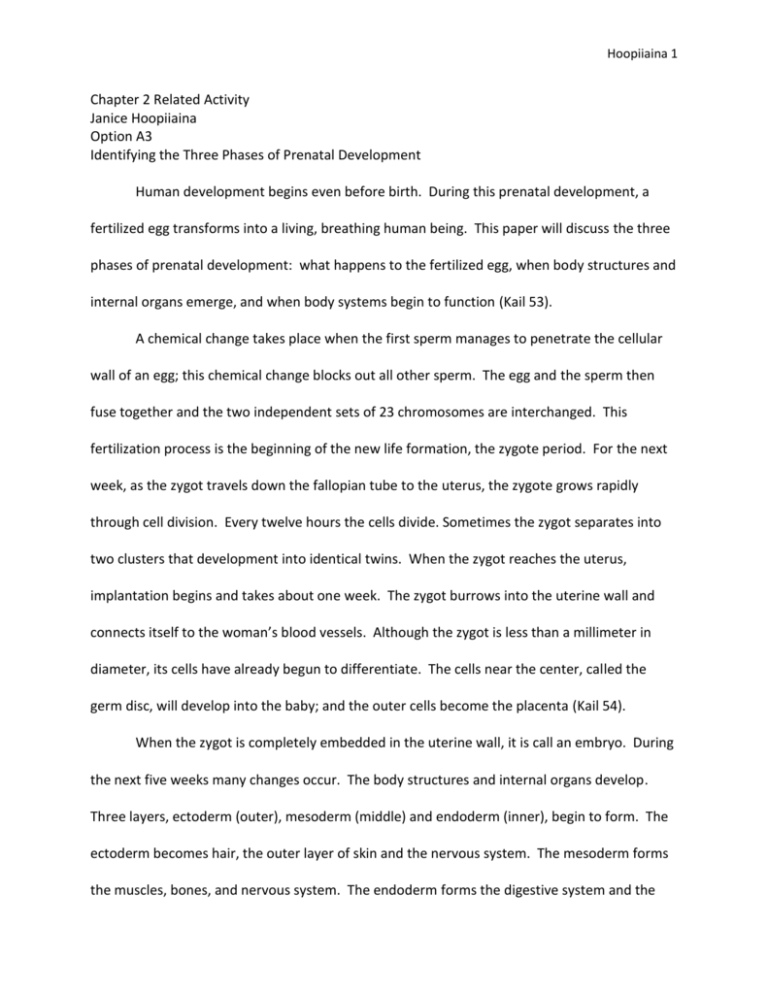File
advertisement

Hoopiiaina 1 Chapter 2 Related Activity Janice Hoopiiaina Option A3 Identifying the Three Phases of Prenatal Development Human development begins even before birth. During this prenatal development, a fertilized egg transforms into a living, breathing human being. This paper will discuss the three phases of prenatal development: what happens to the fertilized egg, when body structures and internal organs emerge, and when body systems begin to function (Kail 53). A chemical change takes place when the first sperm manages to penetrate the cellular wall of an egg; this chemical change blocks out all other sperm. The egg and the sperm then fuse together and the two independent sets of 23 chromosomes are interchanged. This fertilization process is the beginning of the new life formation, the zygote period. For the next week, as the zygot travels down the fallopian tube to the uterus, the zygote grows rapidly through cell division. Every twelve hours the cells divide. Sometimes the zygot separates into two clusters that development into identical twins. When the zygot reaches the uterus, implantation begins and takes about one week. The zygot burrows into the uterine wall and connects itself to the woman’s blood vessels. Although the zygot is less than a millimeter in diameter, its cells have already begun to differentiate. The cells near the center, called the germ disc, will develop into the baby; and the outer cells become the placenta (Kail 54). When the zygot is completely embedded in the uterine wall, it is call an embryo. During the next five weeks many changes occur. The body structures and internal organs develop. Three layers, ectoderm (outer), mesoderm (middle) and endoderm (inner), begin to form. The ectoderm becomes hair, the outer layer of skin and the nervous system. The mesoderm forms the muscles, bones, and nervous system. The endoderm forms the digestive system and the Hoopiiaina 2 lungs. Specialization of the cells proceeds rapidly; and by the eighth week you can see eyes, jaw, arms, and legs (Kail 56). The final and longest phase of prenatal development is the period of the fetus. During this period, the cartilage begins to turn to bone, the baby becomes much larger, and the bodily systems begin to work. This is the time when the mother begins to feel the fetus moving inside her. During the next five months, the fetus gains 7 or 8 pounds before birth. All regions of the brain grow, particularly the cerebral cortex which is the wrinkled surface that regulates many important behaviors. During the fifth and sixth months the skin thickens and is covered with a thick greasy substance called vernix. This substance is to protect the baby while in the amniotic fluid. By twenty-eight weeks, the fetus reaches the age of viability because most systems function well enough to survive. The lungs are not developed and body temperature cannot be regulated because the insulating layer of fat is lacking that develops during the eight month of pregnancy. But with the help of intensive care, the fetus can survive. After the zygot develops into the embryo, and the embryo develops into a fetus, and the fetus reaches the stage of viability, the senses also begin to work. This is a sign of behavioral maturity. Studies have been done that show, before birth, babies can even hear and taste while still in the womb. (Kail 56-58). Reflective Component: Although I have had four babies myself, I did not know what each of the three stages enveloped: zygot, embryo, and fetus. It was interesting to me to learn little details such as how a chemical change takes place when one sperm enters the wall of the egg to block out other sperm. Also, I remember seeing a film like substance, particularly on one of my babies that must have been the vernix; I never knew that it was to protect the baby from Hoopiiaina 3 the amniotic fluid. Additionally, although I had heard that unborn babies can hear the mother’s voice, but learning the study about The Cat in the Hat study really interests me. My daughter is having a baby; she is due on April 1. This is, in fact, why I chose to write about this option. I am excited to talk to her and have her try reading this book to her baby. I know we won’t have a controlling pacifier, but I think it will still be interesting to see if the baby reacts positively to the story after he is born. Course objective: As my daughter’s baby has been developing, she and I have discussed things like how big the baby was, what parts are developed, etc. So I have chosen to apply this writing assignment to objective #9: Make practical application of material from class and text to personal life. How the human body develops has always been of interest to me, but especially now as it is so ‘close to home.” References: Kail, Robert, and John Cavanaugh. Human Development A Life-Span View, Fifth Edition. California: Wadsworth Publishing, 2008. Print.





